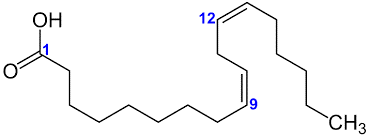
Linoleic Acid is abbreviated as LA in general and is a polyunsaturated omega-6 fatty acid, which is a family of pro-inflammatory and anti-inflammatory polyunsaturated fatty acids. Linoleic Acid exists as a colorless liquid at room temperature. Linoleic Acid belongs to the two families of essential fatty acids, which are fatty acids that humans and other animals must ingest because the body requires them for good health but cannot synthesize them by themselves. Linoleic Acid exists in the lipids of cell membranes in a certain amount and it is also can be found in many nuts, fatty seeds, flax seeds, hemp seeds, poppy seeds,sesame seeds, etc in a large amount.
Scientists at Creative Proteomics utilize a highly quantitative method with high-performance liquid chromatography (HPLC) for the determination of Linoleic Acid levels in various samples, including Tissue, Plant and more. High-Performance Liquid Chromatography (HPLC) with UV detection is used for the determination of Linoleic Acid (203 nm) levels in a lot of biological samples. This Methodology provides accurate, reliable, and reproducible results of Linoleic Acid measurement, which enables us to analyze of Linoleic Acid levels in vitro and in vivo.
Linoleic Acid can be used to biosynthesize of the arachidonic acid, and also is the precursor compounds for synthesizing some prostaglandins, which are a group of physiologically active lipid compounds having diverse hormone-like effects in animals, such as leukotrienes (LTA, LTB, LTC), and thromboxane (TXA). Linoleic Acid is an essential fatty acid, which means that Linoleic Acid must be consumed in the normal health diet. If linoleate, which is the salt form of Linoleic Acid is deficient in a diet may led to mild skin scaling, hair loss and poor wound healing in rats.
The Russian-Polish botanist M. Tswett is generally recognized as the first person to establish the principles of chromatography. In a paper he presented in 1906, Tswett described how he filled a glass tube with chalk powder (CaCO3) and, by allowing an ether solution of chlorophyll to flow through the chalk, separated the chlorophyll into layers of different colors. He called this technique “chromatography”. Fundamentally, chromatography is a technique used to separate the components contained in a sample. High Performance Liquid Chromatography (HPLC) is a method able to separate non-volatile, thermally unstable, and polar components separate or in a mixture. HPLC is a type of chromatography that, because of its wide application range and quantitative accuracy, is regarded as an indispensable analytical technique, particularly in the field of organic chemistry. It is also widely used as a preparation technique for the isolation and purification of target components contained in mixtures.
Linoleic Acid Analysis Service at Creative Proteomics supports your research in Linoleic Acid Analysis. HPLC Based Analysis Service Platform enable us at Creative Proteomics offers you a state-of-the-art Analysis Service.
Sample Type
Various Sample Type
Method
High-Performance Liquid Chromatography (HPLC) with UV detection is used for the determination of Linoleic Acid (203 nm) levels in a lot of biological samples. This Methodology provides accurate, reliable, and reproducible results of Linoleic Acid measurement, which enables us to analyze of Linoleic Acid levels in vitro and in vivo.
Send us your samples, you will get all information that you need!







